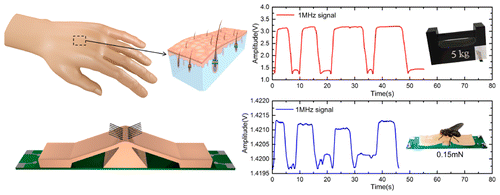Electronic 'hairy skin' could give robots a more human sense of touch

Electronic-skin prototypes are stretchy, thin films that can sense temperature, pressure and even monitor blood oxygen or alcohol levels. But most of these devices are missing a key feature of real skin that allows us to feel a wider range of conditions: hair. Now researchers have combined hair-like wires with electronic skin to make a more versatile sensor for robots, prosthetics and other applications. Their report appears in the journal ACS Applied Materials & Interfaces.
Robots and prosthetics are becoming ever more human-like, but the electronic skins designed to enhance their usefulness don't yet have the full range of tactile senses that we have. For example, they cannot "feel" a light breeze. But fine hair, which covers 95 percent of the human body, helps us feel the slightest wind. To capture that sensation, some researchers have developed separate sensors that mimic this fine hair by sensing and detecting air flow. However, that's about all these particular devices can do. Rongguo Wang, Lifeng Hao and colleagues wanted to expand on this, combining the features of electronic skin and hair in a single device.
The researchers created an array of artificial hairs with glass-coated, cobalt-based microwires and embedded the ends of the wires in a silicon-rubber "skin." The "hairy skin" could repeatedly detect a range of pressures, including the landing of a fly, a light wind and a 10-pound weight. And when used with a two-finger robot gripping a plastic block, the new sensor could "feel" slip and friction forces.
More information: Jian Zhang et al. Biomimic Hairy Skin Tactile Sensor Based on Ferromagnetic Microwires, ACS Applied Materials & Interfaces (2016). DOI: 10.1021/acsami.6b14236
Abstract
We present a multifunctional tactile sensor inspired by human hairy skin structure, in which the sensitive hair sensor and the robust skin sensor are integrated into a single device via a pair of Co-based ferromagnetic microwire arrays in a very simple manner. The sensor possesses a self-tunable effective compliance with respect to the magnitude of the stimulus, allowing a wide range of loading force to be measured. The sensor also exhibits some amazing functions, such as air-flow detection, material property characterization, and excellent damage resistance. The novel sensing mechanism and structure provide a new strategy for designing multifunctional tactile sensors and show great potential applications on intelligent robot and sensing in harsh environments.
Journal information: ACS Applied Materials and Interfaces
Provided by American Chemical Society




















